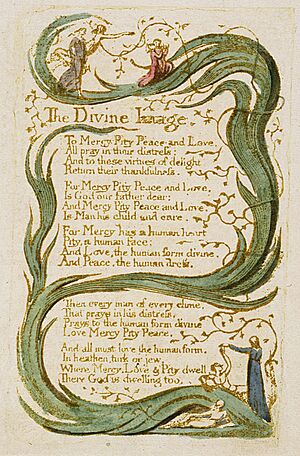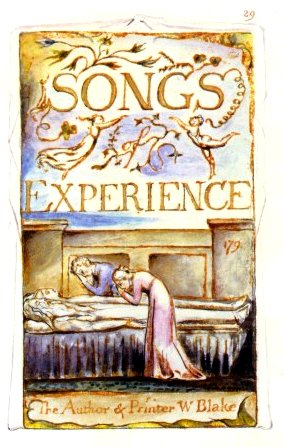Songs of Innocence and of Experience facts for kids
Songs of Innocence and of Experience is a famous collection of illustrated poems by William Blake. Blake was an amazing artist and poet who lived a long time ago. He first printed Songs of Innocence and Songs of Experience as separate books. Each book had its own beautiful pictures.
Later, in 1794, Blake decided to combine them. He called the new book Songs of Innocence and of Experience Shewing the Two Contrary States of the Human Soul. Even after combining them, he still made individual copies of each book sometimes.
Blake was also a painter. He made detailed art for each poem in the collection. He did this by hand, engraving, printing, and coloring each picture. These unique pictures help tell the story of each poem. They were a big part of how Blake wanted people to understand his work. Blake was very interested in children's literature and how kids learn. He believed childhood was a time of innocence and protection. This idea, that children are innocent, became a key part of a movement called Romanticism.
Many musicians have been inspired by Songs of Innocence and of Experience. Poems from the collection have been turned into songs by different artists. The famous band U2 even named two of their albums, Songs of Innocence and Songs of Experience, to honor Blake's book.
Contents
Songs of Innocence
Songs of Innocence was first printed in 1789. It was a complete collection of 23 poems. Blake created 31 special plates to make the artwork for this book. He made about 17 or 18 copies of it.
This collection mostly shows happy and innocent feelings. It often describes a peaceful, natural world. However, some poems, like "The Chimney Sweeper" and "The Little Black Boy", quietly show the dangers that innocent people can face.
Here are the poems in Songs of Innocence:
- Introduction
- The Shepherd
- The Echoing Green
- The Lamb
- The Little Black Boy
- The Blossom
- The Chimney-Sweeper
- The Little Boy Lost
- The Little Boy Found
- Laughing Song
- A Cradle Song
- The Divine Image
- Holy Thursday
- Night
- Spring
- Nurse’s Song
- Infant Joy
- A Dream
- On Another’s Sorrow
- The School Boy
- The Little Girl Lost
- The Little Girl Found
- The Voice of the Ancient Bard
Songs of Experience
Songs of Experience is the second part of Blake's combined book. It has 26 poems. These poems were published in 1794. Some poems, like "The Little Girl Lost" and "The Little Girl Found", were sometimes moved between the two books by Blake.
Here are the poems in Songs of Experience:
- Introduction
- Earth's Answer
- The Clod and the Pebble
- Holy Thursday
- The Chimney Sweeper
- Nurse's Song
- The Sick Rose
- The Fly
- The Angel
- The Tyger
- My Pretty Rose Tree
- Ah! Sun-flower
- The Lilly
- The Garden of Love
- The Little Vagabond
- London
- The Human Abstract
- Infant Sorrow
- A Poison Tree
- A Little Boy Lost
- A Little Girl Lost
- A Divine Image
- A Cradle Song
- To Tirzah
- The School Boy
- The Voice of the Ancient Bard
The Amazing Art in Blake's Books
Blake was famous for his artistic skills. He was great at drawing and making prints. He used these talents when he created Songs of Innocence and Experience. Each page of the book has the poem's words. Around the words, there is a special picture. Blake drew these pictures individually for every copy he made.
He used a special method to create each illustration. First, he would make a relief-etched copper plate by hand. Then, after printing, he would paint each page. He used different art materials, like watercolor. This meant that every copy of Songs of Innocence and of Experience looked a little different.
Blake once said that his book was an attempt to combine the "painter and the Poet." The pictures in his books do more than just show what the poem says. They make the poems stronger and help explain them. The art is very important to fully understand what each poem means. Sometimes, the meaning of a poem even changes because of the picture that goes with it. Good examples are The Blossom and the first picture of The Little Girl Lost.
Music Inspired by Blake
Many composers have set poems from Blake's books to music. Some of these include Ralph Vaughan Williams and Benjamin Britten. Other musicians like John Tavener and Tangerine Dream have also used Blake's poems. A different version of "The Little Black Boy" was even used in a song for the musical Phantom.
The folk musician Greg Brown recorded 16 of the poems. He put them on his 1987 album called Songs of Innocence and of Experience.
The poet Allen Ginsberg thought Blake's poems were meant to be sung. He believed that by studying the rhythm, you could sing them like Blake might have. In 1969, he made an album called Songs of Innocence and Experience by William Blake, tuned by Allen Ginsberg. He sang and played piano on it.
The American composer William Bolcom created music for the entire collection of poems in 1984. In 2005, a recording of Bolcom's work won four Grammy Awards. This was a huge achievement!
The electronic rock band Tangerine Dream used Blake's lyrics for their 1987 album Tyger.
The famous Irish rock band U2 released an album called Songs of Innocence in 2014. They followed it with Songs of Experience in 2017. These albums were named after Blake's work.
Even the legendary American singer-songwriter Bob Dylan mentioned Songs of Experience in his song "I Contain Multitudes". This song is on his 2020 album Rough and Rowdy Ways.



